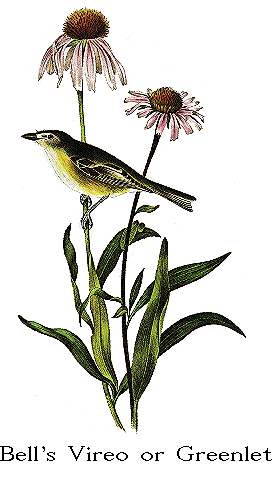Birds of America
By John James Audubon, F. R. SS. L. & E.
VOLUME VII.



Family
Genus

BELL'S VIREO OR GREENLET.
[Bell's Vireo.]
VIREO BELLII, Aud.
[Vireo bellii.]

PLATE CCCCLXXXV.--ADULT MALE.
On the same day that Harris' Finch was procured, Mr. J. G. BELL, who, as I
have already said, accompanied me in my journey to the Yellow Stone river, &c.,
shot one of the species which I am now about to describe, and which I have
named, it being also a new and hitherto undescribed species, with great
pleasure, after Mr. BELL; the more especially as Mr. BELL is himself a person
who possesses a good general knowledge of our birds, and was an excellent
companion in our not unperilous rambles.
This species, like other Vireos of the smaller class, is usually found in
the bottom lands along the shores of the Upper Missouri river, from the
neighbourhood of the Black Snake Hills as far as we went up that river; finding
it in many instances, whether in the bottom lands, overgrown with low shrubbery,
or along the borders of ravines that discharge the water accumulating during the
spring meltings of the snows that cover the upper country prairie land. In its
habits it is probably more nearly allied to the White-eyed Vireo (V.
noveboracensis) than to any other; as although it does not possess all the
swiftness of movement and quaint look exhibited by that species, still it
evinces all the movements usually observable in birds of this family.
We never found its nest, although it doubtless breeds in the countries
which we traversed; as on many occasions, and during the very heat of summer, we
found it as far up the Missouri river as Fort Union, one of the principal and
handsomest factories of the American Fur Company.
BELL'S VIREO or GREENLET, Vireo Bellii, Aud.
4 11/16, 6 11/16.
Shores and prairies of the Upper Missouri, and probably found on all
streams of the Western Territories.
Male.
The upper parts are light greyish-olive, tinged with grey on the head and
shoulders. Wings and tail brown, edged with yellowish-olive. The lower parts
and sides of the neck tinged with yellow, which increases in depth on the sides,
including the inferior tail coverts.
Bill along the ridge 3/8 inch, along the gap 1/2, to end of tail 4 11/16,
inches; alar extent 6 11/16; wing from flexure 2 1/4; tail 1 3/4. Sides brown.
Tarsus 3/4 inch; middle toe 3/8, its claw rather more than 1/8; hind toe 1/4,
its claw (1 1/2)/8.
Bill and feet bluish-grey, lower mandible paler. Third quill longest.
Female a trifle smaller, but resembling the male in every other respect.









